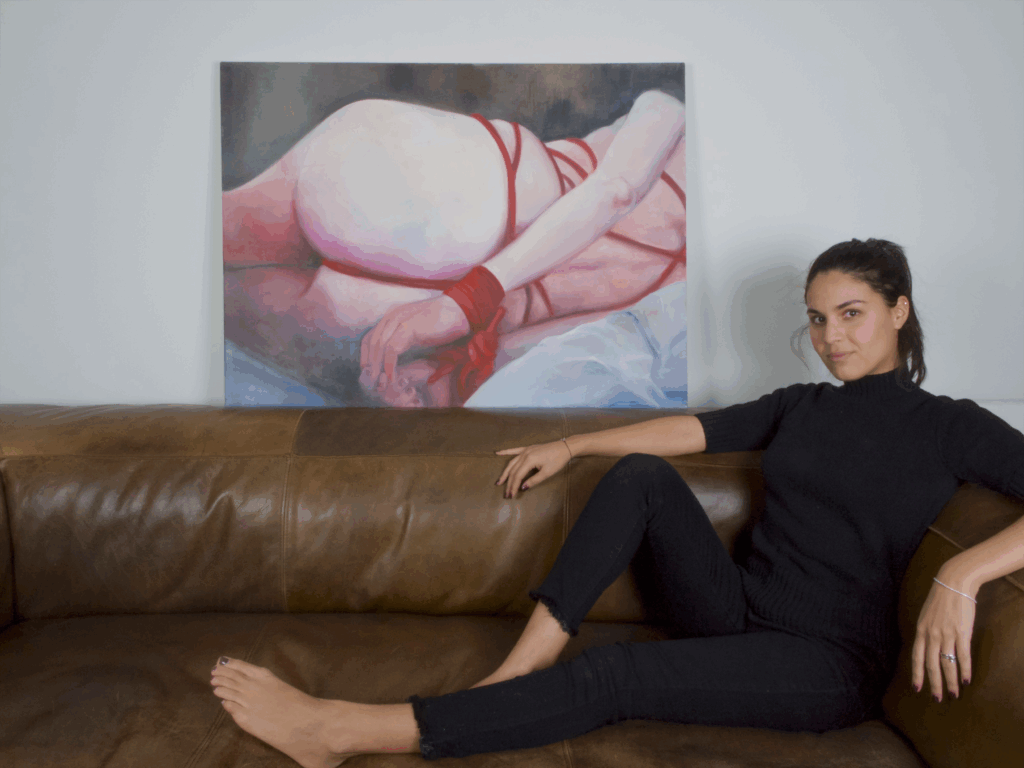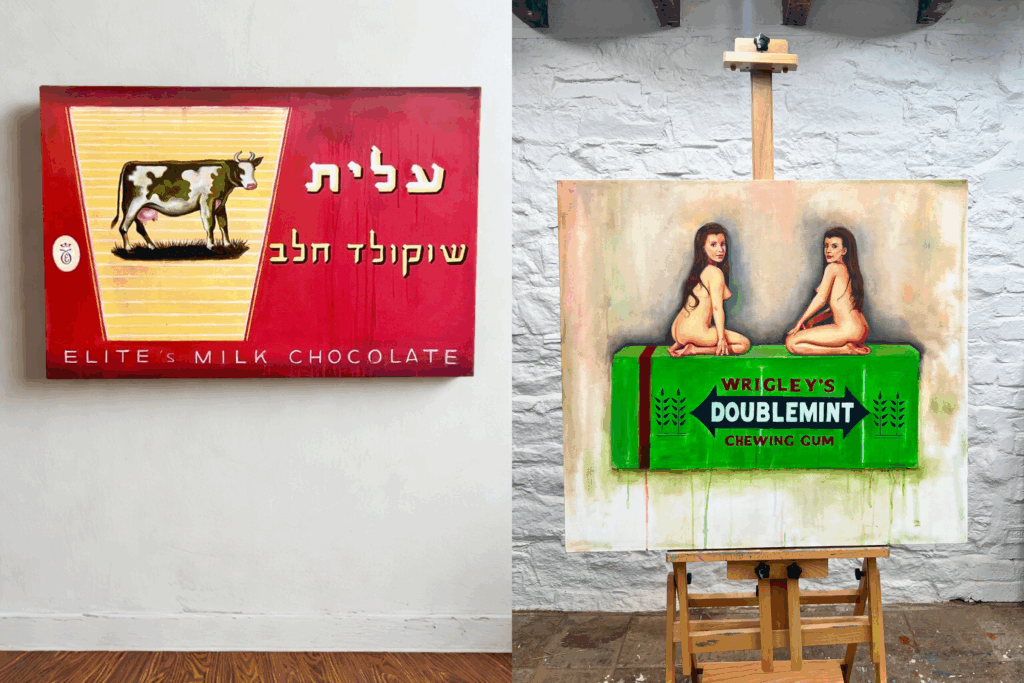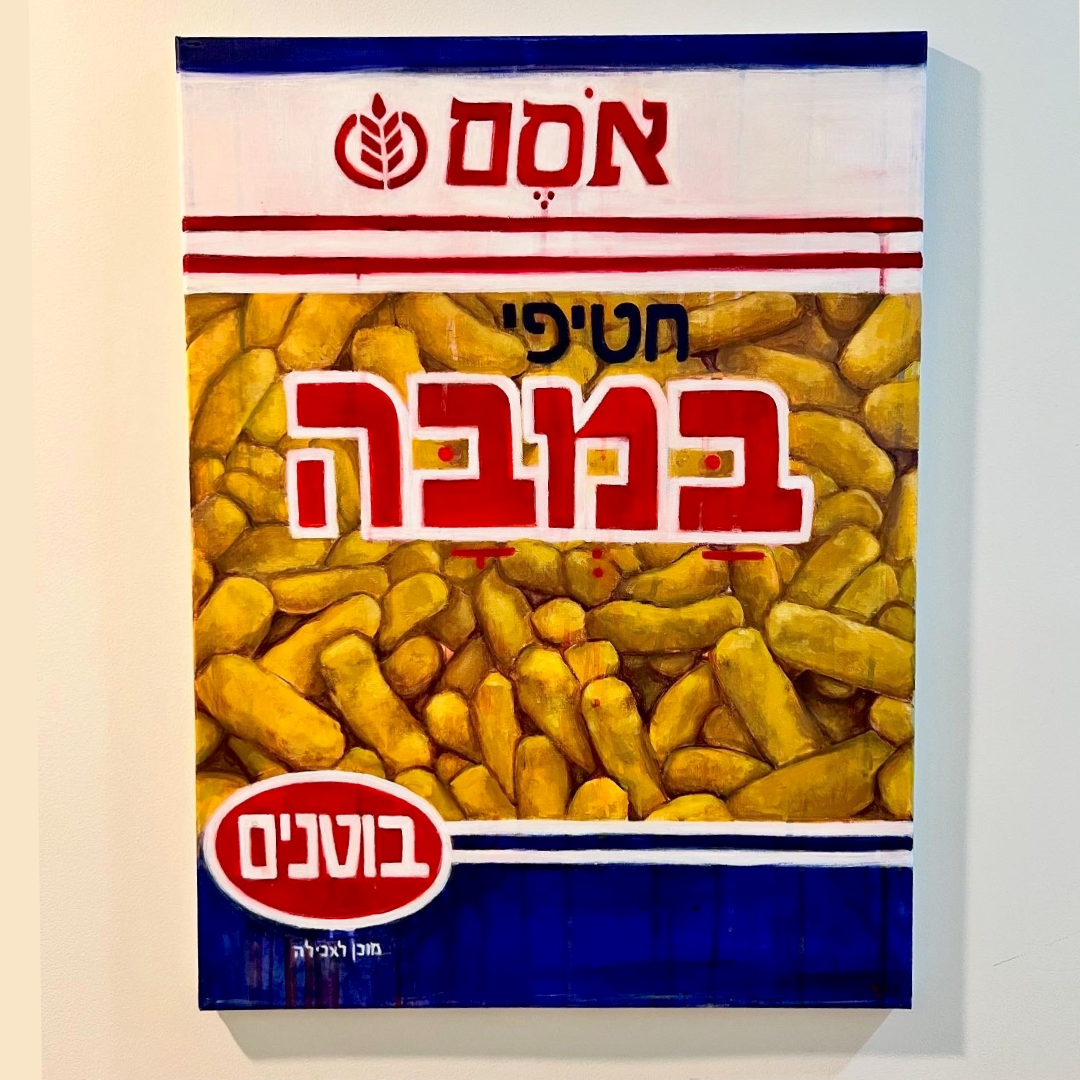Inspired by vintage ads, with their glossy images and playful slogans, she reworks these visuals to question what’s changed and what still lingers today. In this interview with Fine Art Shippers, she shares her perspective on art, the roots of her practice, and what she’s currently working on.
You explore themes such as consumerism, sexuality, and identity. What drew you to these topics?
Samantha Franklin: I’ve always been fascinated by the aesthetics of vintage advertising and the evolution of consumer culture, particularly the way messaging has changed over time. It’s interesting to see how much things have shifted—yet in some ways, they haven’t. I’m curious about how we function in society as consumers, as men and women, and how sexuality intersects with that. For example, I combined the image of Wrigley’s gum with depictions of women as a commentary on how women can be both objectified and empowered.
Recently, my focus has turned more toward identity and heritage. I try to connect with people through shared memories, nostalgia, and a sense of belonging. I want the work to bring joy and create room for dialogue—without leaning too heavily into politics. Humor is a constant in my practice.
You mentioned heritage. Do you see it as American, or something more personal?
For me, it’s very much tied to my Jewish heritage. I’m working on a pop series using imagery from my childhood—things like Bazooka gum, Bamba, or chocolate milk in a bag. These objects are rooted in both American and Israeli-Jewish culture, and I find that cultural crossover really compelling.

Could you talk a little about your creative process? How do you usually develop an idea? Is it more spontaneous, or something you work on over time?
It definitely takes time. I usually begin by researching—looking up references and learning the history behind certain brands or objects. Then I think about how I can subvert that history and place it in a new, playful context. I often introduce a figure that has no direct connection to the product, but together they create a layered narrative with new meaning.
Can you give an example? You mentioned the chewing gum series—how did you approach that?
It started with Juicy Fruit. It reminds me of childhood—being in the car with my friend and his mom, who always chewed it after smoking. That sensory combination stuck with me. When I researched the brand, I found old wrappers from the early to mid-1900s and was drawn to the aesthetics. There’s something about vintage packaging that I love. So I used that as a base and added a sensual figure holding an apple, playing on themes of seduction and temptation. In my Double Mint painting, I paired the gum with the Collinson twins—notorious for being the first identical twin Playmate(s) of the Month in Playboy magazine in 1970, who also starred in the cult Hammer film, Twins of Evil. Gum is a simple object, but layering it with a visual story gives it a new life and hopefully a smile or spark of recognition from the viewer.
What mediums do you usually work with?
I started with charcoal and graphite, doing a lot of figure drawing and still lifes. I actually thought I’d stick with it. But I was encouraged to try oil painting, and that became my primary medium. Lately, I’ve been experimenting more. I just completed a piece where I built a kind of relief on canvas using foam and modeling paste. I’d never worked like that before, but it was exciting to explore. I had this idea and wasn’t sure where to start, but for me it’s all about playing and making use of what you have.
Has your formal training influenced the kind of art you create? Or was it mostly about learning technique?
Formal training gave me a foundation in materials—how to see form, light, and shadow. The fundamentals of drawing and painting. But as I progressed through college, it became more conceptual. That’s when I felt freer to explore ideas I might have avoided before—topics that felt might be “too much” or too personal or might make my family uncomfortable. Art school gave me the push to go deeper and use my work to express what I wouldn’t necessarily say out loud.

So this is essentially about overcoming vulnerability. What helped you move through that and allow yourself to be seen in that new way?
I grew up in a pretty close-knit community, it wasn’t sheltered, but it was definitely a bubble. Most people looked like me and had similar backgrounds. Going to university exposed me to a wide range of cultures and perspectives, and that really opened something up in me.
Seeing others express themselves so openly helped me feel safe doing the same. Art school became a space for self-discovery, where I could explore and share parts of myself I hadn’t before. It gave me the creative freedom to figure out who I am.
You live just outside of New York City, one of the world’s major art centers. How does that environment impact or inspire you?
It can definitely be overwhelming, but it’s also incredibly inspiring. There’s so much art happening all the time—it fuels my motivation to keep painting and to tell my story. My friends and I would often go to Chelsea on Thursday nights, hopping between gallery openings, meeting artists. That kind of energy is exciting, and I feel lucky to be surrounded by it. At the same time, you start to wonder, How do I get there? How do I stand out?
Getting noticed is something a lot of artists struggle with. How do you approach promotion and visibility?
It's definitely a challenge—especially with social media being such a big factor now. It doesn’t always feel natural to me to promote myself online, but I’ve learned to adapt. I use Instagram and LinkedIn, and I try to build relationships with other artists, curators, and people I meet at events. It’s really about making connections—reaching out, sharing updates, letting people know when I have a show coming up. Right now, my focus is on creating and building my portfolio. I know I need to strike more balance with the promotion side, but I’m learning as I go.
Could you share what you’re working on now, maybe a new series or idea you're exploring?
I’m continuing to develop my Israeli pop series, which draws on Jewish culture, childhood memories, and objects that feel personal to me and my family. I’m also working on a few commissions. One is a multimedia piece based on the Hebrew letter Aleph. In Kabbalah, it is considered one of the most mystical letters in the Hebrew alphabet, representing unity, divinity, and the bridge between the spiritual and material worlds. Another is for someone whose husband loves a particular Israeli-American coffee brand, so again, tying into themes of memory and nostalgia.
Interview by Inna Logunova
Photo courtesy of Samantha Franklin
